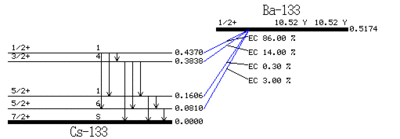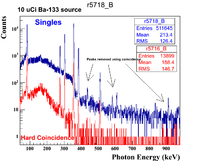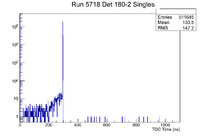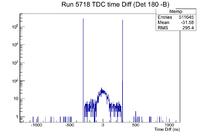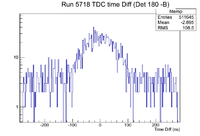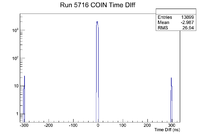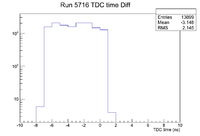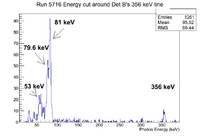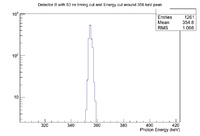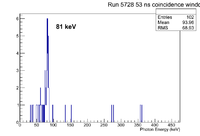R5718-5716 Ba133Analysis
Ba-133 source lines
Ba-133 undergoes electron capture to Cs-133. 86% of the time it ends up in the 1/2+ , 437 keV excited state of Cs-133.
| Energy(keV) | Intensity(rel) |
| 53.1625( 6) | 2.199(22) |
| 79.6139(13) | 2.62( 6) |
| 80.9971(12) | 34.06(27) |
| 160.6109(17) | 0.645( 8) |
| 223.2373(14) | 0.450( 4) |
| 276.3997(13) | 7.164(22) |
| 302.8510( 6) | 18.33( 6) |
| 356.0134( 6) | 62.05(19) |
| 383.8480(12) | 8.94( 3) |
Run list
| Run | Description | |
| 5716 | Coincidences for Ba-133 10 uCi source. The CFD widths were 10 nsec making the coincidence window 20 nsec. running time 7 hrs , 33 min, 14sec. Rate was 1 Hz | |
| 5718 | Logic Unit in OR mode for Ba-133 10 uCi source. The CFD widths were 10 nsec making the coincidence window 20 nsec. running time 2 min, 5 sec. Rate was 4 kHz |
Singles Run 5718 Analysis
Photons from the source
ntuple->Draw("(ADC5-62.1537)/2.82207 >>(4096,0,4096)")
ntuple->Draw("(ADC9-39.8)/2.61747 >>(4096,0,4096)")
Did not observe the 160, 223, lines. The 160 and 223 keV lines have very small relative intensities and are probably in the noise.
| Photon Energy (keV) | Description |
| 82 | Strong, probably the 80.9971 line from the 5/2+ to 7/2+ Cs-133 transition |
| 277 | Medium, probably the 276.3997 line from the 1/2+(437 keV) to the 5/2+ (161 keV) Cs-133 transition |
| 303 | Medium, probably the 302.8510 line from the 3/2+(383 keV) to 5/2+ (81 keV) Cs-133 transition |
| 356 | Strong, likely the 356.0134 line from the 1/2+(437 keV) to 5/2+ (81 keV) Cs-133 transition |
| 384 | Medium, likely the 383.8480 line from the 3/2+ (383 keV) excited state of Cs-133 to the ground state |
| 437 | |
| 510 | Weak |
| 584 | |
| 609 | |
| 911 | |
| 1121 | |
| 1277 | Possibly Na-22 there is a 511 keV line. |
| 1460 | Possibly Eu-148 or Tm-168. Eu-148 has a very strong line at 630 keV and 550 keV but it is not seen. Tm-168 has a strong line at 731 but this is not observed. |
Coincidence Run 5716 Analysis
| Energy of coincidence photon (decay time in seconds) | |
| 53.1622 | 79.6142 (2.16E-10), 80.9979 (6.49E-9), 160.6120 (2.16E-10), 223.2368 (4.39E-11), 302.8508 (4.39E-11), 383.8485 (4.39E-11) |
| 79.6142 | 53.1622 (2.16E-10), 80.9979 (6.28E-9), 223.2368 (1.72E-10), 276.3989 (1.72E-10) |
| 80.9979 | 53.1622 (6.49E-9), 79.6142 (6.28E-9), 223.2368 (6.45E-9), 276.3989 (6.45E-9), 302.8508 (6.28E-9), 356.0129 (6.28E-9) |
| 160.6120 | 53.1622 (2.16E-10), 223.2368 (1.72E-10), 276.3989 (1.72E-10) |
| 223.2368 | 53.1622 (4.39E-11), 79.6142 (1.72E-10), 80.9979 (6.45E-9), 160.6120 (1.72E-10) |
| 276.3989 | 79.6142 (1.72E-10), 80.9979 (6.45E-9), 160.6120 (1.72E-10) |
| 302.8508 | 53.1622 (4.39E-11), 80.9979 (6.28E-9) |
| 356.0129 | 80.9979 (6.28E-9) |
| 383.8485 | 53.1622 (4.39E-11) |
Time Spectrum
- Singles Run 5718
- Coincidence Run 5716 (10 nsec timing window)
Photon Energy
The 81 keV and 356 keV lines are the strongest and, when they occur in coincidence, they represent the transition from the 436 keV excited state of Cs-133 to the 81 keV excited state and then the ground state.
If I put a cut on the strongest line (356 keV) observed by Det B and ask what photon energies are observed in coincidence (timing window of 53 ns) with the other HpGe detector (Detector 180-2) I see the spectrum
Coinc run 5716
Singles Run 5718
- 276 && 306 keV lines http://www.nndc.bnl.gov/nsr/nsrlink.jsp?1995JU02
- Ba-132 83 && 360 http://www.nndc.bnl.gov/nsr/nsrlink.jsp?1996KU01 http://www.nndc.bnl.gov/nsr/nsrlink.jsp?2002GA01
- Ba-132 383 && 515 http://www.nndc.bnl.gov/nsr/nsrlink.jsp?1975GI11
